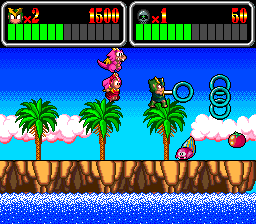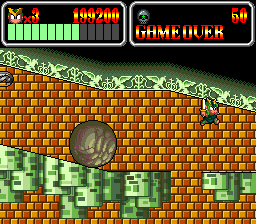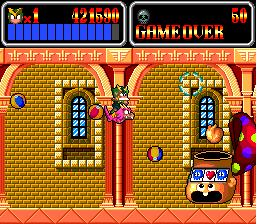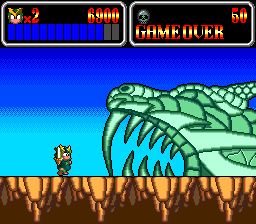This is the first in the series of “From the Lie-Berry,” where I will pull a game from my personal collection (to be put online soon!) and review it, dissect the game design, and hopefully find some insight into how it can be applied to future DORC products. I find a lot of inspiration in older games not because of their perceived “simplicity” but because often their experiences are tighter, the restrictions of the time guiding them towards purer design, budgets were smaller forcing developers to create something that stood out, and and they could deal with a smaller set of variables to create real sculpted experiences.
(all images are from The Video Game Museum)
 Game Summary
Game Summary
Part of the incredibly confusing Wonder Boy series (see links below), this was the third arcade game developed by Westone. The version I’m reviewing is the TurboGrafx-16 CD version, developed by Hudson and released in 1989. This is the only non-SEGA version that got the “Wonder Boy” prefix, but only in the PC-Engine version. As I said, incredibly confusing.
It’s an interesting game, and noteworthy for a number of reasons. Gameplay is similar to the original Wonder Boy, in that your health is constantly draining, and in order to restore it you must pick up fruit that appears at fixed locations through the levels. The setting, however, abandons the original’s cave-person theme and puts it in the cute and deadly/cuddly medieval fantasy world of the later games in the series. Unique amongst all of the games in the series, each level is split into two major parts: a forced-scrolling platformer, and upon entering the dragon-shaped jaws of a cavern, turning into a horizontal shooter with you (and optionally a friend) mounted on cute little dragons. At the end of each shooter segment is a boss, and these are really the highlights of the game.
There are 14 levels in total, each thematically (or at least for the most part) distinct.
 Game Mechanics & Gameplay
Game Mechanics & Gameplay
In the platforming sections, movement has some inertia to it (and this is magnified in the ice levels), but the curves for acceleration and deceleration tend to be very sharp. You still need to be moving at a good clip to make some of the jumps, so there is some analog, but in the shmup areas movement is entirely digital. You are free to move left and right (sliding if you change, depending on your momentum), and up and down whilst dragoning. There is no ducking, unlike later games in the series.
Jumps are digital, although interestingly I found that you could hold up on the D-Pad, the duration you stay aloft will artificially increase. This is reminiscent of using the winged boots in the second title, Wonder Boy in Monster Land, but I have no idea if this was in the arcade original or the Mega Drive versions. On levels with split paths, you can jump “through” a platform above you to land on it, but there’s no way to drop back down through a platform (like you can in Rolling Thunder). You’ll only be jumping in the platform sections, naturally, as the shmup sections have you in full control of your dragon.
One very nice mechanic that was under-utilized in my opinion (except in a few levels where its use is forced upon you) is the ability to grab hold of a ledge if you were about to fall to your death. At this point you have to mash the jump button to pull yourself up; it sounds good, and it is, but this feels like it happens randomly and often by the time you realize what has happened, you are about to be squished by the forced-scrolling anyway.
You begin the game with 3 lives and 3 continues. The game only uses two buttons: one for shoot and one for jump.
The health system is interesting in that you have a health bar that is constantly draining (again, a la the first game). This was probably instituted as a method to end a game in progress in the arcade–Monster Land gave you an hourglass that cost you health if you didn’t finish a level in time or restore it quickly enough–and here it isn’t a real issue. Enemy projectiles will take a tiny bit of health away and put you in a stun state; this also happens when running into static (non-rolling) rocks or occasionally when landing just on the edge of a platform…I guess you stubbed your toe? Collision with an enemy is instant death, as is falling off a cliff; if you have lives left you will reappear carried in by a little critter from the sky, and have some time to move left or right before choosing when to drop.
Fruit appears at fixed points in the levels (sometimes appearing just as you make a leap), and picking them up restores some of your health. The most fun are certain fruits (tomatoes, green pineapples, etc.) that you can pick up immediately, but you can also shoot them (making them grow), and when they pop, they will toss out a bunch of smaller fruits. As Jeff Minter said about the spiders turning into boll-weevils in his Metagalactic Llamas Battle at the Edge of Time, this is “a bit improbable” but doesn’t hinder the fun and adds to the strategy (and confusion). Similar to Twinbee’s bell-juggling system, you will find yourself dying while trying to get just those last damned shots in! Unlike Monster World, none of the fruit is hidden–there aren’t any goodies for jumping in just-the-right-spot.
Weapons! This is where the game shines. Weapons are earned by wiping out a wave of enemies (similar to Gradius) or sometimes for taking out solo opponents. They appear to be randomly generated, without a shuffle algorithm preventing dupes, and this is a good thing:
- Sword: You always have this, and this is what you launch your weapons for. I don’t even know if it does anything; it may be useful against the stupid little snakes that move along the ground beneath your default shots.
- Default Shot: When you don’t have a power-up, you shoot little pea shots out of your sword.
- Shuriken: These move around your character from 0 to 360 degrees circling backwards, at a fixed radius. You can have more than one out at a time; they do good damage but of course you run the risk of colliding with an enemy with their short range.
- Spread Shot: The spread shot fires a ring that splits into multiple rings as it approaches the edge of the screen. Unlike Contra, it doesn’t immediately split, it takes a little bit. Low damage, and you can have a bunch out at once.
- Drill/Laser Shot: Thin blast with high rate of fire that will go through more than one enemy. Nothing special here. You can have a few of these out at once.
- Fore and Aft Fireballs: Well, they’re called fireballs, but they’re grey, more like cannonballs. They fire directly ahead and directly behind you. Only about three out at a time, the rate of fire is low but damage is good and the hit box is sizable.
- Missile: Interesting mechanic. You can only have one of these high damage projectiles out at once, but what is nice is that you they explode after you release the attack button (after a fixed distance). They’ll also explode if they hit an enemy. The explosion covers a good sized chunk of the screen.
- Fireball: Seemingly the rarest of the lot, these large balls of fire circle you once or twice before petering out. They do a good deal of damage, but are pretty overpowered, which can make them fun when they do decide to show up.
Each weapon only lasts around 10 seconds and is not limited by the number of shots fired (like they are in Smash TV, which becomes the real strategy to getting good at that game). Once I discovered this, I found a new player mechanic in that I was switching the turbo switches from weapon-to-weapon. God help the poor PC Engine player, where their pads didn’t come with those! Weapon power-ups are common so if you’re not happy with the one you have, just keep going.
At fixed points in levels, fairies appear; these enbubbled wee folk must be freed, and then touched again (looping in ever-increasing circles), at which point they bestow your character with a minor boon. Some give you health, while others give you temporary invincibility. If there was any visible difference between the two, I wasn’t able to spot it amidst the chaos. Evil little purple warlocks can also be found en-bubbled, and these jerks will turn fruit into poison for a short period of time.
Scoring actually plays a role here, with fruit giving points (the “pump up the fruit”-types giving incrementally-scaling amounts of points). Destroyed enemies, naturally, also give you points. At level end, each player is awarded points based on how long their life bars are. As most injuries result in death anyway, this only adds a little extra strategy and feels more random than anything. You are awarded extra lives at point thresholds, and you will need those extra lives!
 Story
Story
The story isn’t explained in the game, and the manual doesn’t give much. You (under the name of either Leo or Adam, depending on who you believe) and your friend, the princess Puparil (who appears in later Wonder Boy games) are out to stop…alien…invaders? The game’s ending talked about how the invaders wanted a weapon that humanity saved for “when in the jaws of death.” Whatever.
 Level Design
Level Design
The platforming sections are fun, if nothing overly special. There are often times multiple paths (all visible on the same screen), presumably for two players to take different routes and split up the monster killing. They begin in design from Monster Land-esque islands, stereotypical ice worlds, yawn-inducing deserts, and then progress to more interesting fare: the walking mushroom-ridden town straight out of Monster Land, castles, and then more mechanical and eventually space itself.
Design within levels is pretty typical, with the only nice enhancements being long sloped sections (with the camera following you up along them) and platforms that move up, down, shuttle left or right, or bounce along in a nice rhythm. That the level design isn’t spectacular is OK, as the real focus of the game is on the shooting components.
At the end of each platforming segment, you enter a giant cave carved in the shape of the jaws of a huge monster and then transition to the horizontal shooter segments.
These feel a little tacked-on, but give you a chance to fight a few waves of enemies and pick up new weapons. You can easily die in these, as some enemies will come at you from behind, or stun you with projectiles.
At the end of the shooter segment, you will face the bosses, and that’s where the game really shines. Whatever weapon you had upon starting the boss encounter will not time out, although you will lose it if you die. Which can often mean you’re hosed. The scrolling stops during these fights.
 Enemy Design
Enemy Design
The enemies really make the game memorable; their designs are colorful, cute, and funny. Most enemies have a simple pattern, but there is enough variety to keep them feeling fresh, and each level introduces at least one or two new enemy types. Notable enemies include:
- Large blue apes that come in two varieties: those that will drop when you are within a close enough horizontal distance, and those that wait for you to pass under them before dropping. These latter can be tough, as you will often find yourself squeezed between them!
- Gigantic snakes that descend from the top of the screen that require the player to jump to shoot them, and take a bunch of hits to go down.
- A cactus that shoots at you only when shot, and takes a few hits to go down.
- Mushroom dudes that, when shot, lob a projectile (did I mention almost all of the projectiles are colorful beach balls?) in a short arc. Since they come in sequences of 4 or more, you have to keep moving to avoid getting hit by the cascade of arcing projectiles, and time your shots carefully.
- An elephant that takes a lot of hits to take down. He moves in from the right, shoots, then backs up and prepares to shoot again. Unlike most enemies, he keeps himself onscreen and a constant threat until eliminated.
- Monsters that appear at seemingly random locations and in sequence, their only tell being a short puff of smoke.
- Snakes that will make a hop at you when you reach a fixed horizontal distance from them. This hop takes them over most normal shots, so you have to time it carefully or be in the air when they launch. These little guys were re-used in the fantastic Wonder Boy III: The Dragon’s Trap.
- Penguins.
But the real stars of the show are the bosses, and I haven’t seen this much variety (or weirdness) since SEGA’s Fantasy Zone series. Someone really put a lot of time into these guys–or at least most of them. Of note:
- The first boss is a huge fish (doubtful, but possibly an homage to Darius) who sheds his scales, revealing his skeleton beneath. These scales in turn become fish that go flying at your position when they launched. The scales then re-grow and the pattern repeats, all while he floats in a semi-sine wave pattern.
- The second boss is a huge snake that loops around the screen (reminiscent of the snake-like villain in R-Type). His design is one of an aztec/jungle theme, with carved-stone look embedded with gems, so the segments feel at home moving blockily. You must eliminate all of the segments.
- The fourth boss starts as a large honeycomb spewing bees; upon its destruction, it turns into a huge queen bee who moves to different locations and fires increasingly-faster projectiles.
- A giant skull surrounded by a ring of minor deaths. You must eliminate a hole in the ring, get in close, fire on the skull, and get out before the ring contracts back on you. Kind of similar to Star Castle.
- An ice creature that fires chunks of ice at you. In a change-up to the typical Asteroids-mechanic, shooting a chunk of ice makes it bigger, and after reaching a certain size, will shatter. This forces a lot of strategy of when and how to shoot.
- By far the most inventive was a gigantic cactus “head” that fires a bunch of projectiles, and then begins extending a cactus “arm” towards you that snakes around trying to hit you. After reaching a certain distance, the current head disappears and a new one grows at the end of the “arm.” This was a great surprise!
- Giant lobster/crab dude who fires smaller lobster/crab dudes at you, which run along the floor or ceiling.
- And what game is complete without a giant bouncing mushroom with a slot machine for eyes? After absorbing enough damage, it bumbles to the bottom right of the screen and the slot machine is pulled. The results somehow correspond to the fruit and projectiles he spews out, but you won’t be able to pay much attention because his head has popped off and a weird pulsating organ bounces up and down and you have to shoot that about a zillion times.
 Game Experience
Game Experience
The colorful and creative characters give the game a big boost in terms of whimsy and appeal, and the variety of environments and enemy types keeps things from getting stale. The audio sounds great coming off the CD; they took the arcade originals and added an oddly Caribbean feel to most of the songs, and they are largely upbeat and fun.
Controls feel responsive, and as mentioned above the changing of the turbo switches from weapon-to-weapon made it very engaging. The lack of much “game feel” didn’t detract from the experience terribly.
Overall though, the game is a bit overlong and could have used more inventiveness like the cactus boss. Staying true to its arcade roots, it gets tough as nails and would have been a quarter gobbler, if there were coin slots on the TG-16. As it stands, you will likely not have the patience to get good enough at the game to finish it with the default 3 continues; I used the “68K” cheat to go through the entire game.
It might be more fun with 2 players; I have only played it that way once, and we didn’t get very far as both of us were inexperienced with the mechanics.
 Takeaways
Takeaways
- Life system encourages players to keep getting things. Eliminate the “touching an enemy kills you immediately”.
- Forced-scrolling action/platforming can be fun 🙂
- Boss designs are fantastic, look into deriving experiences that can use those core mechanics and expand on them to consistently surprise the player.
- Making weapons feel unique–both in terms of game effects and how the player actually executes them–is key to making a game that is master-able and keeps the player engaged.
- Meaningful weapon choice does not conflict with a lot of available or frequently-available weapon selection.
- Enemy types that can stay around, or have methods of staying in front of a player that is always moving, makes them memorable and forces the player to learn and quickly adapt to new strategies.
- Keeping a “core” weapon that is always available–even if it is only used context-dependent manner–can be a strategy of its own.
- Mixing up gameplay styles–even if the player can predict those shifts–can lead to keeping gameplay fresh.
- Use a dynamic camera to keep level design from feeling flat.
- A scoring system can be implemented that allows master players a new angle of strategy. Cave-developed shooters take this to an extreme, so be careful how to layer this in.
- The “save yourself from a fall” mechanic was great, but it was poorly implemented. Find a way to engage the player with it in a way that doesn’t feel awkward or pre-destined for failure.
- In a situation where the player is “used to” a particular experience–such as the horizontal shooter sections–surprise them with new backgrounds to give a sense of progress and uniqueness to each world.
Offsite Links
- HG101 Summary of the series: A summary of this convoluted–but fantastic–series.
- The Brothers Duomazov review of Monster Lair: Gives another look at the game.
- PC Engine Software Bible review: Yet another perspective.
- Video review by Chris Bucci.

